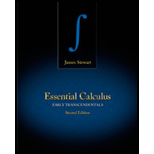
Essential Calculus: Early Transcendentals
2nd Edition
ISBN: 9781133112280
Author: James Stewart
Publisher: Cengage Learning
expand_more
expand_more
format_list_bulleted
Concept explainers
Textbook Question
Chapter 2.2, Problem 5E
Trace or copy the graph of the given function .f. (Assume that the axes have equal scales.) Then use the method of Example 1 to sketch the graph of f' below it.
Example 1
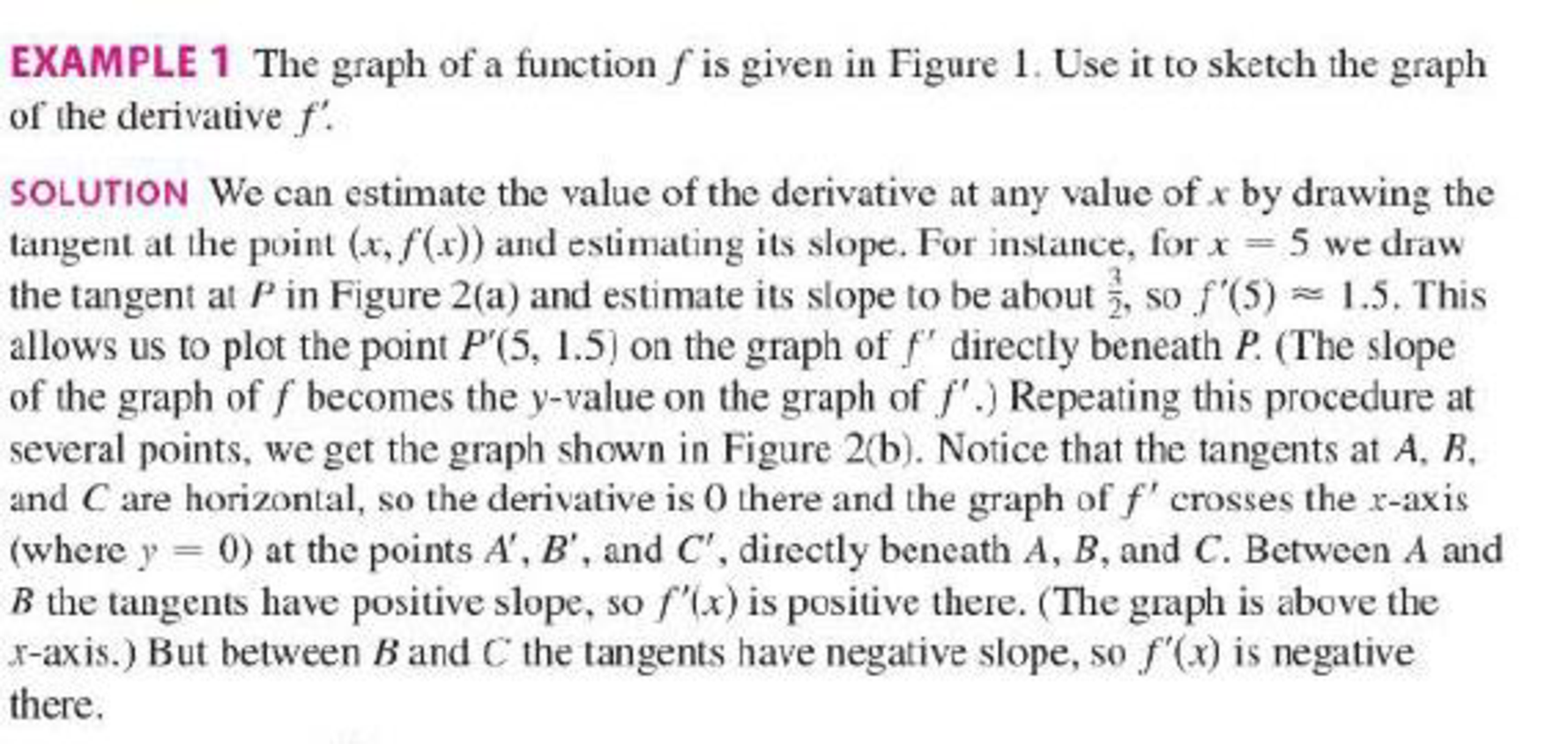
FIGURE 1
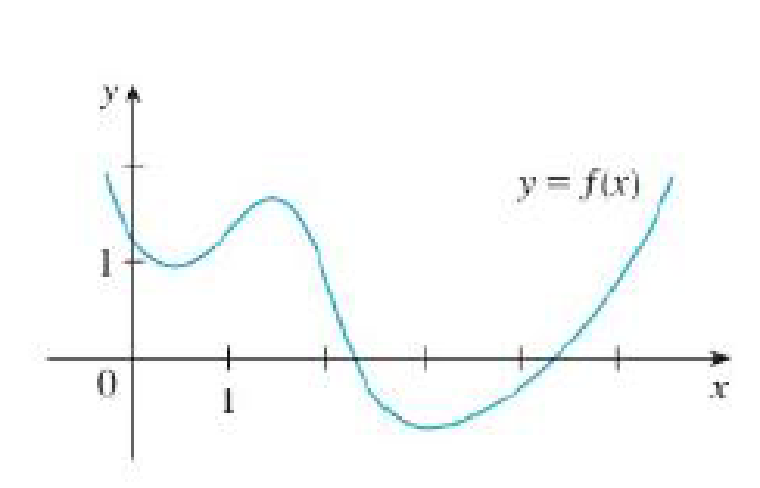
FIGURE 2
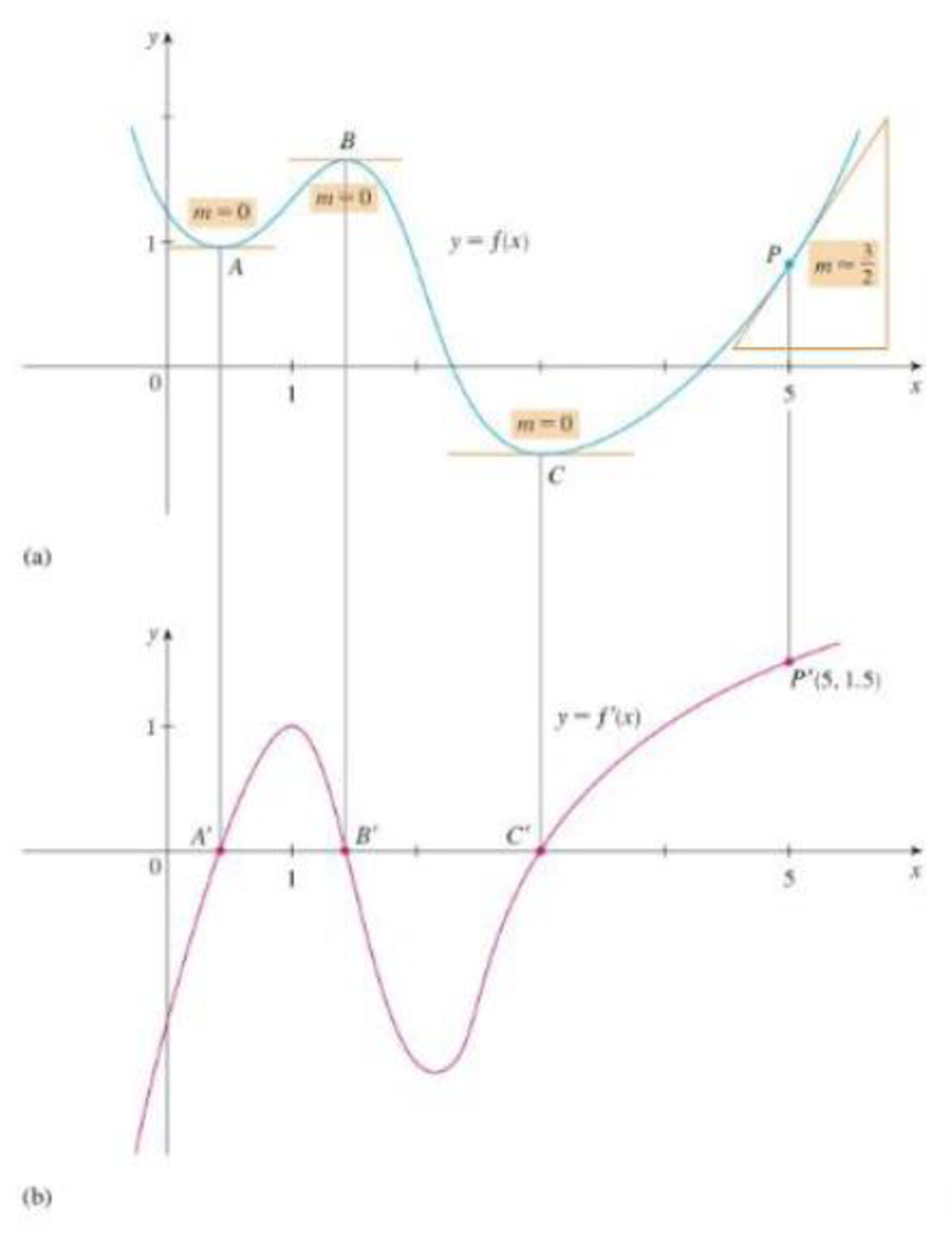
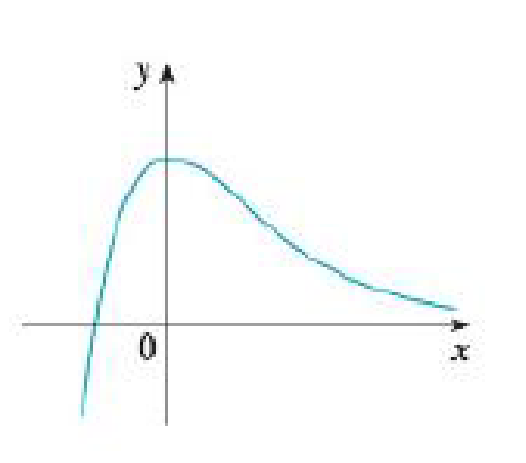
Expert Solution & Answer
Want to see the full answer?
Check out a sample textbook solution
Students have asked these similar questions
Show that the Laplace equation in Cartesian coordinates:
J²u
J²u
+
= 0
მx2 Jy2
can be reduced to the following form in cylindrical polar coordinates:
湯(
ди
1 8²u
+
Or 7,2 მ)2
= 0.
Find integrating factor
Draw the vertical and horizontal asymptotes. Then plot the intercepts (if any), and plot at least one point on each side of each vertical asymptote.
Chapter 2 Solutions
Essential Calculus: Early Transcendentals
Ch. 2.1 - (a) Find the slope of the tangent line to the...Ch. 2.1 - (a) Find the slope of the tangent line to the...Ch. 2.1 - Find an equation of the tangent line to the curve...Ch. 2.1 - Find an equation of the tangent line to the curve...Ch. 2.1 - Find an equation of the tangent line to the curve...Ch. 2.1 - Find an equation of the tangent line to the curve...Ch. 2.1 - (a) Find the slope of the tangent to the curve y =...Ch. 2.1 - (a) Find the slope of the tangent to the curve...Ch. 2.1 - The graph shows the position function of a car....Ch. 2.1 - Shown are graphs of the position functions of two...
Ch. 2.1 - If a ball is thrown into the air with a velocity...Ch. 2.1 - If an arrow is shot upward on the moon with a...Ch. 2.1 - The displacement (in meters) of a particle moving...Ch. 2.1 - The displacement (in meters) of a particle moving...Ch. 2.1 - Prob. 15ECh. 2.1 - Find an equation of the tangent line to the graph...Ch. 2.1 - If an equation of the tangent tine to the curve y...Ch. 2.1 - If the tangent line to y= f(x) at (4, 3) passes...Ch. 2.1 - Sketch the graph of a function f for which f(0) =...Ch. 2.1 - Sketch the graph of a function g for which g(0) =...Ch. 2.1 - If f(x) = 3x2 x3 , find f'(l) and use it to find...Ch. 2.1 - Prob. 22ECh. 2.1 - (a) If F(x) = 5x/(l + x2), find F'(2) and use it...Ch. 2.1 - Prob. 24ECh. 2.1 - Find f'(a). f(x) = 3x2 4x + 1Ch. 2.1 - Find f'(a). f(t) = 2t3 + tCh. 2.1 - Prob. 27ECh. 2.1 - Prob. 28ECh. 2.1 - Prob. 29ECh. 2.1 - Prob. 30ECh. 2.1 - Each limit represents the derivative of some...Ch. 2.1 - Each limit represents the derivative of some...Ch. 2.1 - Prob. 33ECh. 2.1 - Prob. 34ECh. 2.1 - Prob. 35ECh. 2.1 - 3136 Each limit represents the derivative of some...Ch. 2.1 - Prob. 37ECh. 2.1 - Prob. 38ECh. 2.1 - The number N of US cellular phone subscribers (in...Ch. 2.1 - The number N of locations of a popular coffeehouse...Ch. 2.1 - Prob. 41ECh. 2.1 - If a cylindrical tank holds 100,000 gallons of...Ch. 2.1 - The cost of producing x ounces of gold from a new...Ch. 2.1 - The number of bacteria after r hours in a...Ch. 2.1 - Prob. 45ECh. 2.1 - Prob. 46ECh. 2.1 - Prob. 47ECh. 2.1 - The graph shows the influence of the temperature T...Ch. 2.1 - Prob. 49ECh. 2.1 - Prob. 50ECh. 2.2 - Use the given graph to estimate the value of each...Ch. 2.2 - Use the given graph to estimate the value of each...Ch. 2.2 - Match the graph of each function in (a)(d) with...Ch. 2.2 - Trace or copy the graph of the given function .f....Ch. 2.2 - Trace or copy the graph of the given function .f....Ch. 2.2 - Prob. 6ECh. 2.2 - Prob. 7ECh. 2.2 - Prob. 8ECh. 2.2 - Prob. 9ECh. 2.2 - Trace or copy the graph of the given function .f....Ch. 2.2 - Trace or copy the graph of the given function .f....Ch. 2.2 - Shown is the graph of the population function P(t)...Ch. 2.2 - Prob. 13ECh. 2.2 - Prob. 14ECh. 2.2 - Prob. 15ECh. 2.2 - Prob. 16ECh. 2.2 - Prob. 17ECh. 2.2 - Prob. 18ECh. 2.2 - Find the derivative of the function using the...Ch. 2.2 - Find the derivative of the function using the...Ch. 2.2 - Find the derivative of the function using the...Ch. 2.2 - Find the derivative of the function using the...Ch. 2.2 - Find the derivative of the function using the...Ch. 2.2 - Find the derivative of the function using the...Ch. 2.2 - Prob. 25ECh. 2.2 - Prob. 26ECh. 2.2 - Prob. 27ECh. 2.2 - Prob. 28ECh. 2.2 - Prob. 29ECh. 2.2 - Prob. 30ECh. 2.2 - The unemployment rate U(t) varies with time. The...Ch. 2.2 - Prob. 32ECh. 2.2 - Prob. 33ECh. 2.2 - Prob. 34ECh. 2.2 - Prob. 35ECh. 2.2 - The graph of f is given. State, with reasons, the...Ch. 2.2 - Prob. 37ECh. 2.2 - Prob. 38ECh. 2.2 - Prob. 39ECh. 2.2 - Prob. 40ECh. 2.2 - Prob. 41ECh. 2.2 - Use the definition of a derivative to find f'(x)...Ch. 2.2 - Prob. 42ECh. 2.2 - If f(x) = 2x2 x3, find f'(x), f"(x), f'"(x), and...Ch. 2.2 - Prob. 45ECh. 2.2 - Prob. 46ECh. 2.2 - Prob. 47ECh. 2.2 - Where is the greatest integer function f(x) = [[ x...Ch. 2.2 - Prob. 49ECh. 2.2 - Prob. 50ECh. 2.2 - Prob. 51ECh. 2.3 - Differentiate the function. f(x) = 240Ch. 2.3 - Differentiate the function. f(x)=2Ch. 2.3 - Differentiate the function. f(t)=223tCh. 2.3 - Differentiate the function. F(x)=34x8Ch. 2.3 - Prob. 5ECh. 2.3 - Differentiate the function. f(t) = 1.4t5 2.5t2+...Ch. 2.3 - Prob. 9ECh. 2.3 - Prob. 10ECh. 2.3 - Prob. 11ECh. 2.3 - Differentiate the function. B(y) = cy6Ch. 2.3 - Differentiate the function. A(s)=12s5Ch. 2.3 - Prob. 14ECh. 2.3 - Prob. 15ECh. 2.3 - Differentiate the function. y=x(x1)Ch. 2.3 - Prob. 17ECh. 2.3 - Prob. 20ECh. 2.3 - Prob. 21ECh. 2.3 - Prob. 18ECh. 2.3 - Differentiate the function. z=Ay10+BcosyCh. 2.3 - Prob. 22ECh. 2.3 - Differentiate the function. y=x2+4x+3xCh. 2.3 - Differentiate the function. y=sin2+cCh. 2.3 - Prob. 25ECh. 2.3 - Prob. 26ECh. 2.3 - Prob. 7ECh. 2.3 - Prob. 8ECh. 2.3 - Prob. 27ECh. 2.3 - Prob. 28ECh. 2.3 - Prob. 29ECh. 2.3 - Prob. 30ECh. 2.3 - Prob. 31ECh. 2.3 - Prob. 34ECh. 2.3 - Prob. 33ECh. 2.3 - Prob. 32ECh. 2.3 - Prob. 43ECh. 2.3 - Prob. 44ECh. 2.3 - Prob. 55ECh. 2.3 - Find the points on the curve y = 2x3 + 3x2 12x +...Ch. 2.3 - Prob. 37ECh. 2.3 - Show that the curve y = 6x3 + 5x 3 has no tangent...Ch. 2.3 - Find an equation of the tangent line to the curve...Ch. 2.3 - Prob. 41ECh. 2.3 - Prob. 42ECh. 2.3 - Prob. 61ECh. 2.3 - Prob. 62ECh. 2.3 - Prob. 57ECh. 2.3 - Prob. 36ECh. 2.3 - Prob. 59ECh. 2.3 - Prob. 65ECh. 2.3 - Prob. 64ECh. 2.3 - Prob. 48ECh. 2.3 - Prob. 58ECh. 2.3 - Prob. 60ECh. 2.3 - Prob. 67ECh. 2.3 - Prob. 66ECh. 2.3 - For what values of a and b is the line 2x + y = b...Ch. 2.3 - Prob. 68ECh. 2.3 - Prob. 69ECh. 2.3 - Draw a diagram showing two perpendicular lines...Ch. 2.3 - Prob. 71ECh. 2.3 - Prob. 72ECh. 2.3 - Prob. 35ECh. 2.3 - Prob. 45ECh. 2.3 - Prob. 46ECh. 2.3 - If a ball is thrown vertically upward with a...Ch. 2.3 - If a rock is thrown vertically upward from the...Ch. 2.3 - The position function of a particle is given by s...Ch. 2.3 - Prob. 53ECh. 2.3 - Prob. 54ECh. 2.3 - Prob. 56ECh. 2.3 - Prob. 51ECh. 2.3 - The cost function for production of a commodity is...Ch. 2.4 - Find the derivative of f(x) = (1 + 2x2)(x x2) in...Ch. 2.4 - Find the derivative o f the function...Ch. 2.4 - Differentiate. g(t)=t3costCh. 2.4 - Differentiate. f(x)=xsinxCh. 2.4 - Differentiate. g(x)=1+2x34xCh. 2.4 - Differentiate. G(x)=x222x+1Ch. 2.4 - Differentiate. h()=csccotCh. 2.4 - Differentiate. J(v) = (v3 2v)(v4 + v2)Ch. 2.4 - Prob. 5ECh. 2.4 - Differentiate. y=sincosCh. 2.4 - Differentiate. y=x31x2Ch. 2.4 - Differentiate. y=x+1x3+x2Ch. 2.4 - Differentiate. y=v32vvvCh. 2.4 - Differentiate. g(t)=ttt1/3Ch. 2.4 - Differentiate. f(t)=2t2+tCh. 2.4 - Differentiate. y=x1x+1Ch. 2.4 - Differentiate. f()=sec1+secCh. 2.4 - Differentiate. y=1secxtanxCh. 2.4 - Prob. 24ECh. 2.4 - Differentiate. f(x)=xx+cxCh. 2.4 - Find an equation of the tangent line to the given...Ch. 2.4 - Find an equation of the tangent line to the given...Ch. 2.4 - Prob. 31ECh. 2.4 - Prob. 32ECh. 2.4 - Prob. 33ECh. 2.4 - Prob. 41ECh. 2.4 - Prob. 42ECh. 2.4 - If f and g are the functions whose graphs are...Ch. 2.4 - Let P(x) = F(x)G(x) and Q(x) = F(x)/G(x), where F...Ch. 2.4 - Prob. 45ECh. 2.4 - Prob. 46ECh. 2.4 - Prob. 47ECh. 2.4 - Prob. 48ECh. 2.4 - Prob. 49ECh. 2.4 - Prob. 50ECh. 2.4 - Prob. 53ECh. 2.4 - Prob. 54ECh. 2.4 - Prob. 55ECh. 2.4 - Prob. 56ECh. 2.4 - Prob. 57ECh. 2.4 - Prob. 26ECh. 2.4 - Prob. 7ECh. 2.4 - Differentiate. y = 2 sec x csc xCh. 2.4 - Prob. 19ECh. 2.4 - Differentiate. y=cosx1sinxCh. 2.4 - Prob. 23ECh. 2.4 - Prob. 37ECh. 2.4 - Prob. 38ECh. 2.4 - Prob. 39ECh. 2.4 - Find an equation of the tangent line to the curve...Ch. 2.4 - Prob. 30ECh. 2.4 - Prob. 35ECh. 2.4 - Prob. 34ECh. 2.4 - Prob. 40ECh. 2.4 - A mass on a spring vibrates horizontally on a...Ch. 2.4 - Prob. 52ECh. 2.4 - Prob. 36ECh. 2.5 - Write the composite function in the form f(g(x))....Ch. 2.5 - Write the composite function in the form f(g(x))....Ch. 2.5 - Write the composite function in the form f(g(x))....Ch. 2.5 - Write the composite function in the form f(g(x))....Ch. 2.5 - Write the composite function in the form f(g(x))....Ch. 2.5 - Write the composite function in the form f(g(x))....Ch. 2.5 - Find the derivative of the function. F(x) = (x4 +...Ch. 2.5 - Find the derivative of the function. F(x) = (4x ...Ch. 2.5 - Find the derivative of the function. F(x)=12xCh. 2.5 - Find the derivative of the function....Ch. 2.5 - Prob. 11ECh. 2.5 - Find the derivative of the function. f(t)=1+tant3Ch. 2.5 - Prob. 13ECh. 2.5 - Prob. 14ECh. 2.5 - Prob. 15ECh. 2.5 - Prob. 16ECh. 2.5 - Find the derivative of the function. f(x) = (2x ...Ch. 2.5 - Find the derivative of the function. g(x) = (x2 +...Ch. 2.5 - Prob. 19ECh. 2.5 - Prob. 20ECh. 2.5 - Find the derivative of the function. y=(x2+1x21)3Ch. 2.5 - Find the derivative of the function. f(s)=s2+1s2+4Ch. 2.5 - Find the derivative of the function. y=sin(xcosx)Ch. 2.5 - Prob. 24ECh. 2.5 - Prob. 25ECh. 2.5 - Prob. 26ECh. 2.5 - Prob. 27ECh. 2.5 - Prob. 28ECh. 2.5 - Prob. 29ECh. 2.5 - Prob. 30ECh. 2.5 - Prob. 31ECh. 2.5 - Prob. 32ECh. 2.5 - Prob. 33ECh. 2.5 - Prob. 34ECh. 2.5 - Find the derivative of the function. y = cot2(sin...Ch. 2.5 - Prob. 36ECh. 2.5 - 742 Find the derivative of the function. 37....Ch. 2.5 - Find the derivative of the function. y=x+x+xCh. 2.5 - Prob. 39ECh. 2.5 - 742 Find the derivative of the function. 40....Ch. 2.5 - Prob. 41ECh. 2.5 - Prob. 42ECh. 2.5 - Prob. 43ECh. 2.5 - Prob. 44ECh. 2.5 - Prob. 45ECh. 2.5 - Prob. 46ECh. 2.5 - Prob. 48ECh. 2.5 - Prob. 47ECh. 2.5 - Prob. 49ECh. 2.5 - Prob. 50ECh. 2.5 - Prob. 51ECh. 2.5 - Prob. 52ECh. 2.5 - Prob. 53ECh. 2.5 - Prob. 54ECh. 2.5 - A table of values for f, g, f, and g is given. (a)...Ch. 2.5 - Prob. 56ECh. 2.5 - Prob. 57ECh. 2.5 - Prob. 58ECh. 2.5 - Prob. 59ECh. 2.5 - Prob. 60ECh. 2.5 - Prob. 61ECh. 2.5 - Prob. 62ECh. 2.5 - Prob. 75ECh. 2.5 - Prob. 76ECh. 2.5 - Prob. 63ECh. 2.5 - Prob. 64ECh. 2.5 - Prob. 65ECh. 2.5 - Prob. 66ECh. 2.5 - Prob. 67ECh. 2.5 - Prob. 68ECh. 2.5 - Prob. 69ECh. 2.5 - Air is being pumped into a spherical weather...Ch. 2.5 - Prob. 72ECh. 2.5 - Prob. 71ECh. 2.5 - Prob. 74ECh. 2.5 - Use the Chain Rule to show that if is measured in...Ch. 2.5 - Prob. 78ECh. 2.5 - Prob. 77ECh. 2.6 - (a) Find y by implicit differentiation. (b) Solve...Ch. 2.6 - (a) Find y by implicit differentiation. (b) Solve...Ch. 2.6 - Find dy/dx by implicit differentiation. x3 + y3 =...Ch. 2.6 - Find dy/dx by implicit differentiation. 2x3 + x2y ...Ch. 2.6 - Prob. 5ECh. 2.6 - Find dy/dx by implicit differentiation. y5 + x2y3...Ch. 2.6 - Find dy/dx by implicit differentiation. 11. y cos...Ch. 2.6 - Find dy/dx by implicit differentiation. 12....Ch. 2.6 - Prob. 9ECh. 2.6 - Prob. 10ECh. 2.6 - Prob. 11ECh. 2.6 - Find dy/dx by implicit differentiation. x+y=1+x2y2Ch. 2.6 - 3-16 Find dy/dx by implicit differentiation. 13....Ch. 2.6 - Prob. 14ECh. 2.6 - Prob. 15ECh. 2.6 - Find dy/dx by implicit differentiation. 20....Ch. 2.6 - Prob. 17ECh. 2.6 - If g(x) + x sin g(x) = x2, find g(0).Ch. 2.6 - Use implicit differentiation to find an equation...Ch. 2.6 - Prob. 19ECh. 2.6 - Use implicit differentiation to find an equation...Ch. 2.6 - Prob. 22ECh. 2.6 - Use implicit differentiation to find an equation...Ch. 2.6 - Prob. 24ECh. 2.6 - Prob. 29ECh. 2.6 - Prob. 30ECh. 2.6 - Prob. 25ECh. 2.6 - Prob. 26ECh. 2.6 - Prob. 27ECh. 2.6 - Prob. 28ECh. 2.6 - Find the points on the lemniscate in Exercise 23...Ch. 2.6 - Show by implicit differentiation that the tangent...Ch. 2.6 - Show that the sum of the x-and y-intercepts of any...Ch. 2.6 - Prob. 41ECh. 2.6 - Prob. 35ECh. 2.6 - Prob. 36ECh. 2.6 - Prob. 37ECh. 2.6 - Prob. 38ECh. 2.6 - Prob. 47ECh. 2.6 - Prob. 48ECh. 2.6 - Prob. 39ECh. 2.6 - Prob. 43ECh. 2.6 - Prob. 44ECh. 2.6 - Prob. 45ECh. 2.6 - Prob. 46ECh. 2.6 - Prob. 49ECh. 2.6 - Prob. 50ECh. 2.7 - Prob. 1ECh. 2.7 - (a) If A is the area of a circle with radius r and...Ch. 2.7 - Prob. 3ECh. 2.7 - The length of a rectangle is increasing at a rate...Ch. 2.7 - A cylindrical tank with radius 5 m is being filled...Ch. 2.7 - The radius of a sphere is increasing at a rate of...Ch. 2.7 - Prob. 7ECh. 2.7 - Prob. 8ECh. 2.7 - Prob. 9ECh. 2.7 - A particle is moving along a hyperbola xy = 8. As...Ch. 2.7 - Prob. 13ECh. 2.7 - (a) What quantities are given in the problem? (b)...Ch. 2.7 - (a) What quantities are given in the problem? (b)...Ch. 2.7 - (a) What quantities are given in the problem? (b)...Ch. 2.7 - Two cars start moving from the same point. One...Ch. 2.7 - A spotlight on the ground shines on a wall 12m...Ch. 2.7 - Prob. 17ECh. 2.7 - Prob. 18ECh. 2.7 - Prob. 19ECh. 2.7 - Prob. 20ECh. 2.7 - Prob. 21ECh. 2.7 - Prob. 22ECh. 2.7 - Prob. 24ECh. 2.7 - A trough is 10 ft long and its ends have the shape...Ch. 2.7 - Prob. 26ECh. 2.7 - Prob. 27ECh. 2.7 - Prob. 28ECh. 2.7 - Prob. 29ECh. 2.7 - Prob. 30ECh. 2.7 - Prob. 31ECh. 2.7 - Prob. 32ECh. 2.7 - Prob. 33ECh. 2.7 - Prob. 34ECh. 2.7 - Prob. 35ECh. 2.7 - Prob. 36ECh. 2.7 - Prob. 23ECh. 2.7 - Prob. 37ECh. 2.7 - A lighthouse is located on a small island 3 km...Ch. 2.7 - Prob. 39ECh. 2.7 - Prob. 40ECh. 2.7 - Prob. 41ECh. 2.7 - Prob. 42ECh. 2.8 - Find the linearization L(x) of the function at a....Ch. 2.8 - Prob. 2ECh. 2.8 - Prob. 3ECh. 2.8 - Prob. 4ECh. 2.8 - Prob. 5ECh. 2.8 - Prob. 6ECh. 2.8 - Prob. 7ECh. 2.8 - Prob. 10ECh. 2.8 - 7-10 Verify the given linear approximation at a =...Ch. 2.8 - Prob. 8ECh. 2.8 - Prob. 18ECh. 2.8 - Prob. 17ECh. 2.8 - Let y = tan x. (a) Find the differential dy. (b)...Ch. 2.8 - Let y = tan x. (a) Find the differential dy. (b)...Ch. 2.8 - Prob. 11ECh. 2.8 - Prob. 14ECh. 2.8 - Use a linear approximation (or differentials) to...Ch. 2.8 - Prob. 13ECh. 2.8 - Prob. 15ECh. 2.8 - Prob. 16ECh. 2.8 - Prob. 21ECh. 2.8 - Prob. 22ECh. 2.8 - The circumference of a sphere was measured to be...Ch. 2.8 - Prob. 24ECh. 2.8 - One side of a right triangle is known to be 20 cm...Ch. 2.8 - Prob. 25ECh. 2.8 - When blood flows along a blood vessel, the flux F...Ch. 2.8 - Prob. 28ECh. 2.8 - Prob. 29ECh. 2.8 - Suppose that we dont have a formula for g(x) but...Ch. 2 - Prob. 1RCCCh. 2 - Prob. 2RCCCh. 2 - Prob. 4RCCCh. 2 - Prob. 3RCCCh. 2 - Prob. 5RCCCh. 2 - Prob. 6RCCCh. 2 - Prob. 7RCCCh. 2 - Prob. 1RQCh. 2 - Prob. 8RQCh. 2 - Determine whether the statement is true or false....Ch. 2 - Prob. 2RECh. 2 - Prob. 3RECh. 2 - Prob. 4RECh. 2 - Prob. 5RECh. 2 - Prob. 6RECh. 2 - Prob. 63RECh. 2 - Prob. 7RECh. 2 - Prob. 9RECh. 2 - Prob. 8RECh. 2 - Prob. 8RCCCh. 2 - Prob. 9RCCCh. 2 - Prob. 10RCCCh. 2 - Prob. 11RCCCh. 2 - Prob. 2RQCh. 2 - Prob. 3RQCh. 2 - Prob. 4RQCh. 2 - Prob. 5RQCh. 2 - Prob. 6RQCh. 2 - Prob. 12RQCh. 2 - Prob. 7RQCh. 2 - Prob. 11RQCh. 2 - Prob. 9RQCh. 2 - Prob. 13RECh. 2 - Prob. 14RECh. 2 - Prob. 15RECh. 2 - Prob. 16RECh. 2 - Prob. 17RECh. 2 - Prob. 19RECh. 2 - Prob. 33RECh. 2 - Prob. 1RECh. 2 - Prob. 10RECh. 2 - Prob. 11RECh. 2 - Prob. 12RECh. 2 - Prob. 18RECh. 2 - Prob. 20RECh. 2 - Prob. 21RECh. 2 - Prob. 22RECh. 2 - Prob. 23RECh. 2 - Prob. 25RECh. 2 - Prob. 26RECh. 2 - Prob. 36RECh. 2 - Prob. 37RECh. 2 - Prob. 38RECh. 2 - Prob. 24RECh. 2 - Prob. 27RECh. 2 - Prob. 28RECh. 2 - Prob. 29RECh. 2 - Prob. 30RECh. 2 - Prob. 31RECh. 2 - Prob. 39RECh. 2 - Prob. 35RECh. 2 - Prob. 32RECh. 2 - Prob. 34RECh. 2 - Prob. 40RECh. 2 - Prob. 41RECh. 2 - Prob. 42RECh. 2 - Prob. 43RECh. 2 - Prob. 44RECh. 2 - Prob. 45RECh. 2 - Prob. 46RECh. 2 - Prob. 47RECh. 2 - Prob. 48RECh. 2 - Prob. 49RECh. 2 - Prob. 50RECh. 2 - Prob. 51RECh. 2 - 70. If f and g are the functions whose graphs are...Ch. 2 - Prob. 53RECh. 2 - Prob. 54RECh. 2 - Prob. 55RECh. 2 - Prob. 57RECh. 2 - Prob. 56RECh. 2 - Prob. 58RECh. 2 - Prob. 59RECh. 2 - Prob. 60RECh. 2 - Prob. 61RECh. 2 - Prob. 62RECh. 2 - Prob. 65RECh. 2 - Prob. 64RECh. 2 - Prob. 66RECh. 2 - Prob. 67RECh. 2 - Prob. 68RECh. 2 - Prob. 69RECh. 2 - Prob. 70RECh. 2 - Prob. 71RECh. 2 - Prob. 72RECh. 2 - Prob. 73RECh. 2 - Prob. 74RECh. 2 - Prob. 75RECh. 2 - Prob. 76RECh. 2 - Prob. 77RECh. 2 - Prob. 78RECh. 2 - Evaluate limx01+tanx1+sinxx3.Ch. 2 - Prob. 80RECh. 2 - Prob. 81RECh. 2 - Prob. 82RE
Knowledge Booster
Learn more about
Need a deep-dive on the concept behind this application? Look no further. Learn more about this topic, calculus and related others by exploring similar questions and additional content below.Similar questions
- Draw the asymptotes (if there are any). Then plot two points on each piece of the graph.arrow_forwardCancel Done RESET Suppose that R(x) is a polynomial of degree 7 whose coefficients are real numbers. Also, suppose that R(x) has the following zeros. -1-4i, -3i, 5+i Answer the following. (a) Find another zero of R(x). ☐ | | | | |│ | | | -1 བ ¢ Live Adjust Filters Croparrow_forwardSuppose that R (x) is a polynomial of degree 7 whose coefficients are real numbers. Also, suppose that R (x) has the following zeros. -1-4i, -3i, 5+i Answer the following. (c) What is the maximum number of nonreal zeros that R (x) can have? ☐arrow_forward
- Suppose that R (x) is a polynomial of degree 7 whose coefficients are real numbers. Also, suppose that R (x) has the following zeros. -1-4i, -3i, 5+i Answer the following. (b) What is the maximum number of real zeros that R (x) can have? ☐arrow_forwardi need help please dont use chat gptarrow_forward3.1 Limits 1. If lim f(x)=-6 and lim f(x)=5, then lim f(x). Explain your choice. x+3° x+3* x+3 (a) Is 5 (c) Does not exist (b) is 6 (d) is infinitearrow_forward
- 1 pts Let F and G be vector fields such that ▼ × F(0, 0, 0) = (0.76, -9.78, 3.29), G(0, 0, 0) = (−3.99, 6.15, 2.94), and G is irrotational. Then sin(5V (F × G)) at (0, 0, 0) is Question 1 -0.246 0.072 -0.934 0.478 -0.914 -0.855 0.710 0.262 .arrow_forward2. Answer the following questions. (A) [50%] Given the vector field F(x, y, z) = (x²y, e", yz²), verify the differential identity Vx (VF) V(V •F) - V²F (B) [50%] Remark. You are confined to use the differential identities. Let u and v be scalar fields, and F be a vector field given by F = (Vu) x (Vv) (i) Show that F is solenoidal (or incompressible). (ii) Show that G = (uvv – vVu) is a vector potential for F.arrow_forwardA driver is traveling along a straight road when a buffalo runs into the street. This driver has a reaction time of 0.75 seconds. When the driver sees the buffalo he is traveling at 44 ft/s, his car can decelerate at 2 ft/s^2 when the brakes are applied. What is the stopping distance between when the driver first saw the buffalo, to when the car stops.arrow_forward
- Topic 2 Evaluate S x dx, using u-substitution. Then find the integral using 1-x2 trigonometric substitution. Discuss the results! Topic 3 Explain what an elementary anti-derivative is. Then consider the following ex integrals: fed dx x 1 Sdx In x Joseph Liouville proved that the first integral does not have an elementary anti- derivative Use this fact to prove that the second integral does not have an elementary anti-derivative. (hint: use an appropriate u-substitution!)arrow_forward1. Given the vector field F(x, y, z) = -xi, verify the relation 1 V.F(0,0,0) = lim 0+ volume inside Se ff F• Nds SE where SE is the surface enclosing a cube centred at the origin and having edges of length 2€. Then, determine if the origin is sink or source.arrow_forward4 3 2 -5 4-3 -2 -1 1 2 3 4 5 12 23 -4 The function graphed above is: Increasing on the interval(s) Decreasing on the interval(s)arrow_forward
arrow_back_ios
SEE MORE QUESTIONS
arrow_forward_ios
Recommended textbooks for you
- Algebra & Trigonometry with Analytic GeometryAlgebraISBN:9781133382119Author:SwokowskiPublisher:Cengage

 Glencoe Algebra 1, Student Edition, 9780079039897...AlgebraISBN:9780079039897Author:CarterPublisher:McGraw Hill
Glencoe Algebra 1, Student Edition, 9780079039897...AlgebraISBN:9780079039897Author:CarterPublisher:McGraw Hill  Elementary Linear Algebra (MindTap Course List)AlgebraISBN:9781305658004Author:Ron LarsonPublisher:Cengage Learning
Elementary Linear Algebra (MindTap Course List)AlgebraISBN:9781305658004Author:Ron LarsonPublisher:Cengage Learning College Algebra (MindTap Course List)AlgebraISBN:9781305652231Author:R. David Gustafson, Jeff HughesPublisher:Cengage Learning
College Algebra (MindTap Course List)AlgebraISBN:9781305652231Author:R. David Gustafson, Jeff HughesPublisher:Cengage Learning College AlgebraAlgebraISBN:9781305115545Author:James Stewart, Lothar Redlin, Saleem WatsonPublisher:Cengage Learning
College AlgebraAlgebraISBN:9781305115545Author:James Stewart, Lothar Redlin, Saleem WatsonPublisher:Cengage Learning

Algebra & Trigonometry with Analytic Geometry
Algebra
ISBN:9781133382119
Author:Swokowski
Publisher:Cengage


Glencoe Algebra 1, Student Edition, 9780079039897...
Algebra
ISBN:9780079039897
Author:Carter
Publisher:McGraw Hill

Elementary Linear Algebra (MindTap Course List)
Algebra
ISBN:9781305658004
Author:Ron Larson
Publisher:Cengage Learning

College Algebra (MindTap Course List)
Algebra
ISBN:9781305652231
Author:R. David Gustafson, Jeff Hughes
Publisher:Cengage Learning

College Algebra
Algebra
ISBN:9781305115545
Author:James Stewart, Lothar Redlin, Saleem Watson
Publisher:Cengage Learning
Area Between The Curve Problem No 1 - Applications Of Definite Integration - Diploma Maths II; Author: Ekeeda;https://www.youtube.com/watch?v=q3ZU0GnGaxA;License: Standard YouTube License, CC-BY